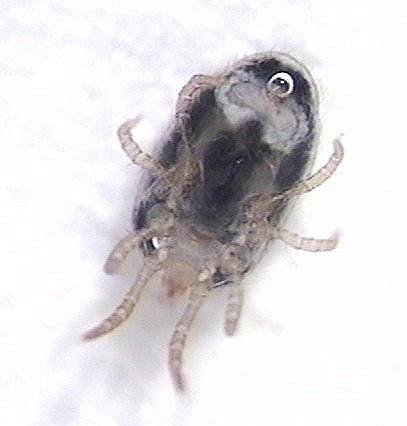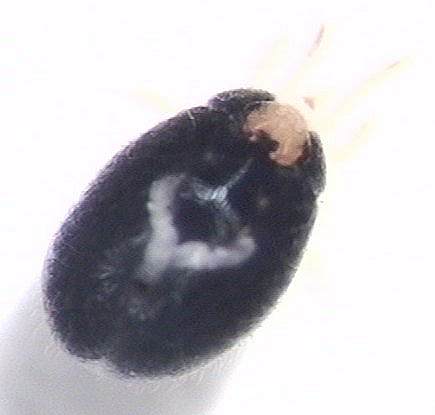How do I recognize snake mites?
Similar to ticks, mites don’t reach a very significant size (about 1.0mm) until they have fed. Before feeding, they are often too tiny to be recognized, until the entire enclosure is infested. Therefore, the bitter conclusion: Upon the first sight of mites, the whole enclosure is already completely infested.
In most case, the problem becomes apparent, because the snake (angered by the inactivity of its keeper) takes measures in its own hands (so to speak), and tries to drown the unwanted guests through constant soaking. The mites, fat and well nourished (and thereby well visible), appear as little black or red dots floating at the bottom of the water container.
This already concludes their physical description, as little more is visible to the naked eye.
At this point, the first tip: Do not use black or dark water containers for the snake to drink from and soak in. Due to the lack of contrast, you will otherwise have major difficulties in discovering the mites. The drowned buggers are well visible in white or light colored water containers.
As owners of numerous black water containers, we know what we are talking about…
If mites can be seen on the body of the snake with the bare eyes, the infestation has often reached dramatic proportions already. It is similar to rats: For every one that you see, there are one hundred that are hiding. Especially the inside of the snake’s retreat or the corners of the enclosure are suitable spots for the mites to hide at.
In severely infested boas, abnormalities on the scales around the eyes can be seen, as these areas are preferred spots for mites. If the eyes of the snake appear to be severely minimized, a massive mite infestation is likely the cause.
Fighting Mites / Treatment of snake mites
An effective treatment must
- kill the mites
- rid the enclosure of the mites
- kill the mite eggs
…and all of this without hurting the reptile.
There is a little bit of difficulty with the last aspect, because every substance has possible side effects. Therefore, we cannot guarantee that the administration of the described substances for the treatment of mites has no side effects in boas.
Neguvon
This substance was the pioneer in the treatment of mites, and took good care of the mites (and occasionally the snake as well). However, it is not worth discussing this substance in much detail, because Neguvon is no longer allowed in Germany, and has been taken off the market (Dr. Kirmair, veterinarian at LRA Mühldorf/Inn and reptile specialist, pers. communication).
 Snake mite (Ophionyssus natricis)
Snake mite (Ophionyssus natricis)
photo: Kalle Berglof, Sweden
Olive Oil and other Oils
Thirty or forty years ago, the pioneers of boid husbandry applied an olive oil anointing to their charges, which resulted in shiny snakes. Although the oil kills the mites by suffocation, this method is not exactly ideal for the oxygen absorption through the skin of the snake. Also, problems with the next shed are to be expected, due to a possibly insufficient level of friction. Therefore: Please do not use the oil method, even if this does get the snake rather slimy - just the way most people picture snakes in their nightmares.
Dichlorvos
In our opinion, Dichlorvos was the best repellant against mites on snakes and in the vivarium at all.
It is thanks to a EU - regulation (with every passing day we grow more fond of the EU) that this substance has been removed from the market.
Something with a similar positive effect that does not harm the boas is not available so far.
If you know of something don't hesitate to contact us. We appreciate every hint.
Boa constrictor mites | treatment of snake mites | fighting mites | Boa has mites |Boa constrictor mite problem | Frontline | Dichlorvos | Baygon | Blattanex | how to get rid of mites | how to kill mites | mite eggs | Boa constrictor mite issue | mites IBD | snake mites
Frontline®
The previously mentioned substances for the treatment of mites are relatively old, and science has not stopped progressing. One of the more recent products is called Frontline® (effective ingredient: Fipronil). Once again, it must be considered that Frontline® is not officially recommended for treating reptiles.
Even though it is effective in many species of reptiles, the exact compatibility in individual species or specimens cannot be predicted. We found the way that the substance eliminates the mites to be rather interesting. Fipronil is effective on contact, hindering the GABA (=Gamma-Amino-Butyric acid) receptor in the target organism.
What does that mean? While many toxins cause paralysis in the central nervous system, Frontline® does the exact opposite: It causes an over-stimulation. Simply put, you could say that, following contact with Fipronil, the mites are permanently bouncing off the walls at top speed in the red zone of the speed gauge until they die from exhaustion.
As with Dichlorvos, the veteran of chemical warfare against mites, Frontline® also has no effects on the eggs.
 Snake mite (Ophionyssus natricis)
Snake mite (Ophionyssus natricis)
photo: Kalle Berglof, Sweden
But now to the application of Fipronil:
Dr. Petra Kölle from the Institute for Zoology, Fish Biology and Fish Diseases at the University of Munich (Germany) recommends in a publication („kleintier“, Enke Verlag 2/00) to spray the fluid on a disposable glove, and to gently rub the animal with it. According to Dr. Kölle, all reptiles that have been treated with it have so far tolerated the spray.
Much more thorough is the method of treatment suggested by Ian Calvert of the Zetland Veterinary Group BRISTOL. Unfortunately, this suggested method is rather impractical for the most part, maybe even impossible to execute.
For instance, Calvert recommends heating the enclosure to 95 degree Centigrade (203° Fahrenheit) for 3 or 4 hours (and this repeatedly in 3 to 4 week intervals), after being thoroughly sprayed with Frontline®. Since most boid enclosures are unlikely to fit into the stove or microwave, this thermal warfare recommended by Calvert proves to be rather difficult to implement.
We therefore limit this to those parts that seem to be of practical use:
The snake is to be weighted. Specimens of more than 500g of bodyweight should be treated with 6 pumps per kg of bodyweight from the 100ml bottle (of which one pump spray goes behind the head and the cloaca, respectively). It is recommended to protect the eyes of the animal with an eye crème. In animals with less than 500g of bodyweight, the spray solution should be thinned out with alcohol at a 1:1 ratio.
This is done as follows: 0.5ml of Frontline® (=1 pump) is combined with 0.5ml of alcohol. You apply 0.1ml of the well-shaken solution per 20g of bodyweight of the snake. The solution can be dripped over the snake, directly applied with gloves, paper towels, cotton balls, or q-tips.
You should consider working with minor dosages in the first application, especially when treating young animals. Since alcohols steam damages the lungs, the boa cannot be placed into the enclosure or into a poorly ventilated container. For the temporary housing over the next few hours, a wide-mesh cloth bag is suitable (Note by the authors: The room, in which you are letting the snake air out, must contain suitable temperatures).
The effect that Frontline® has on the fat layer has not been tested. Damage to the epidermal fat layer can increase the fluid loss by up to 15 times. It therefore has to be made certain that the boa has access to a high humidity hide spot, following the treatment. Ian Calvert recommends repeating the application three to four times in 3 to 4 week intervals.
According to this suggested treatment method, the application of Fipronil should not be considered or should be rescheduled in any of the following cases:
- in generally sick animals
- in snakes that are currently being treated with fluoquinolones (e.g. Enrofloxacin = Baytril®)
- in boas that are currently breeding
- in snakes that are in shed
The fact that this has repeatedly resulted in breathing problems and even fatalities following the application in neonate boas is quite alarming, and utmost caution is therefore highly recommended!
With Dichlorvos and Fipronil, we have introduced you to the best suitable methods for the elimination of snake mites, in our opinion. There are other methods, however, whose effectiveness is either dubious or requires medical knowledge for proper application.
Ridding the Enclosure of Mites
While both snake and enclosure are practically rid of mites in one application of Dichlorvos, the Frontline® treatment requires additional measures for the enclosure. The more complex an enclosure is designed, the more difficult these measures are to implement. You should definitely consider this aspect before turning your enclosure into a miniature version of the tropical rainforest.
First, the entire substrate must be discarded right away. Next, every piece of cage furniture that is not somehow permanently installed is to be thrown out as well; clay pots and ceramic water containers are to be heat treated in the oven.
The spouse may vehemently protest against placing a mite-infested ceramic bowl in the oven, but no worries - once the spouse has furiously left the house after a colorful debate to run to her (recently divorced) girlfriend, you can comfortably fill up the oven after all.
Afterwards, you mist the enclosure thoroughly with 100% isopropyl alcohol from the pharmacy. A spray bottle, like the ones used for watering plants, is best suitable for this. The alcohol kills the mites (even drink-proof specimens) as well as their eggs. After a period of several hours, the enclosure has to be aired out thoroughly and cleaned with clear water. Finally, the snake can move back in.
